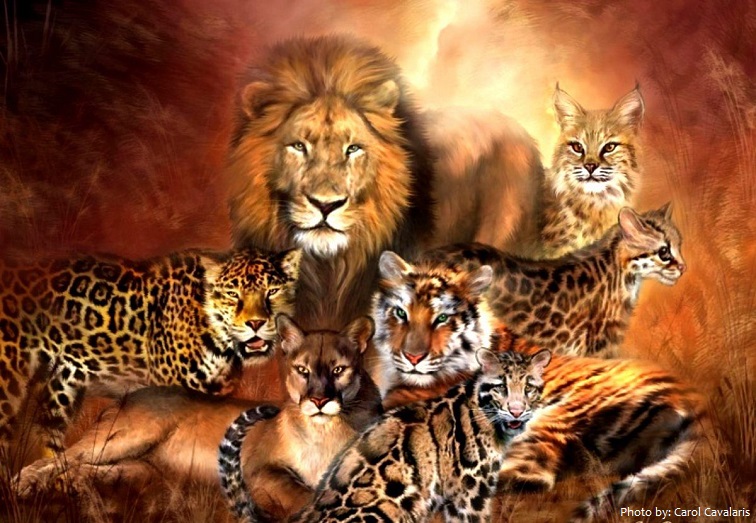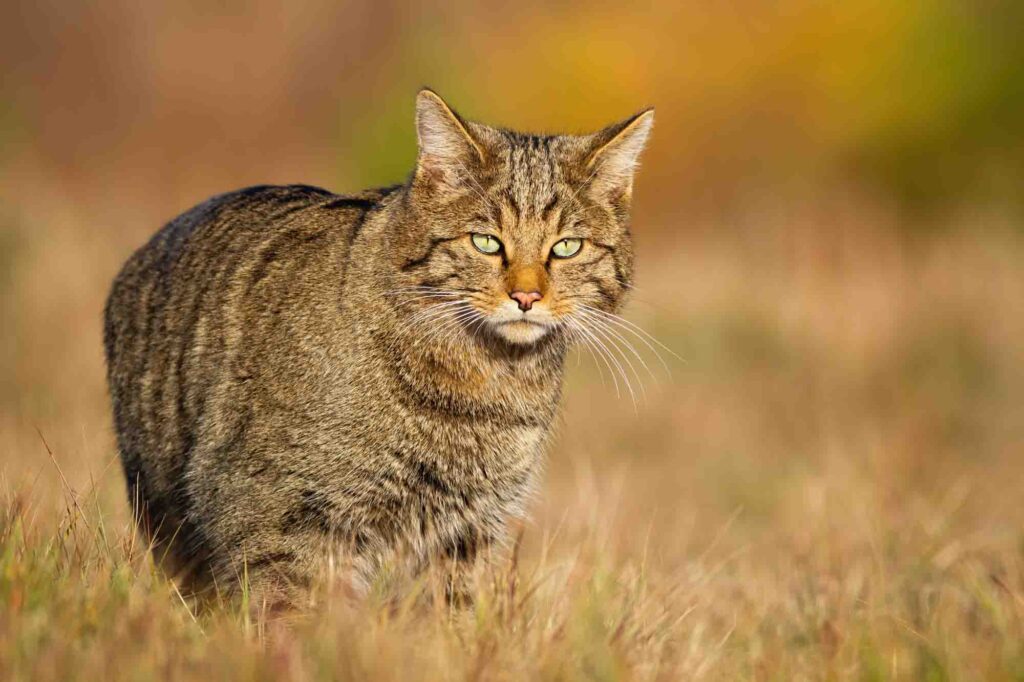11/ 28/2023 by Active Wild Admin
activewild.com
Chinese Mountain Cat
Alternative names: Chinese desert cat; Chinese steppe cat
Scientific name: Felis bieti
Subfamily: Felinae
Where found: Western China
Conservation status: Vulnerable
The Chinese Mountain cat is a mid-sized wild cat found only in western China. Its coat is pale yellow-grey with faint stripes, & its tail has black rings.
This secretive cat is active at night, preying on small vertebrates such as rodents & birds. It lives in forests & grasslands in mountainous regions.
Clouded Leopard
Alternative name: Mainland clouded leopard
Scientific name: Neofelis nebulosa
Subfamily: Pantherinae
Where found: Asia
Conservation status: Vulnerable
This medium-large Asian wild cat is named for its cloud-like markings. It is found on mainland Southeast Asia, & is sometimes called the mainland clouded leopard to distinguish it from the closely-related Sunda clouded leopard.
The clouded leopard has among the longest canine teeth in relation to body size of any cat. This forest cat has a long tail, which is used for balance & support when the cat is climbing in the trees.
A skillful climber, the clouded leopard rests in the trees during the day, coming down to the forest floor at night to hunt.
Cougar
Alternative names: puma, cougar, catamount
Scientific name: Puma concolor
Subfamily: Felinae
Where found: North America; South America
Conservation status: Least Concern
The mountain lion is a large wild cat found in both North & South America. The species is also commonly known as both the puma & the cougar.
The species’ large range stretches from northern Canada to the Andes in South America. It is found in a wide range of habitats, including forests, grasslands, & deserts.
The mountain lion is the second-largest cat of the Americas (the Jaguar is the largest), & the 4th-largest of all cat species. Despite being (on average) larger than a leopard, the mountain lion is not considered to be a big cat, as it cannot roar.
The species is a stealthy ambush predator whose favored prey is deer. It will also prey on livestock.
Domestic Cat
Scientific name: Felis catus
Subfamily: Felinae
Where found: All continents except Antarctica
Conservation status: Domestic
The domestic cat is thought to have originated from wildcats that were tamed around 9,000 to 10,000 years ago. Around 95 million domestic cats are kept in the USA, making cats the country's second most popular pet, after fish.
Despite its domestication, the cat remains an effective predator of small mammals & birds. Sadly, a downside of widespread cat ownership is the negative effect these predators can have on local wildlife.
Eurasian Lynx
Scientific name: Lynx lynx
Subfamily: Felinae
Where found: Europe; Asia
Conservation status: Least Concern
The Eurasian lynx has a large range that includes south-eastern & central Europe, together with parts of Asia, including China, India, Iran, & Pakistan. It has a number of subspecies, including the northern lynx, Balkan lynx, & Siberian lynx.
The Eurasian lynx is a medium-sized wild cat. It is the largest lynx species, weighing between 18 & 30 kg (40 & 66 lb.). It has a red-brown spotted coat, with paler undersides.
Like all lynxes, the Eurasian lynx has tufted ears, long powerful legs, & a short ‘bobbed’ tail.
European Wildcat
Scientific name: Felis silvestris
Subfamily: Felinae
Where found: Europe
Conservation status: Least Concern
The European wildcat is a small cat that is widely distributed across Europe. It is usually found in forests, typically avoiding human settlements.
There is much debate of the classification of the wildcat. It is genetically very similar to the domestic cat & other species in the genus Felis, which includes species such as the jungle cat, sand cat, & black footed cat.
Some biologists consider the domestic cat to be a subspecies of wildcat. The wildcat & domestic cat can breed, & in some areas this can be a threat to the continued existence of pure wildcats.
Most wildcats are slightly larger & stockier than domestic cats. The species has gray or pale gold fur, with faint spots or stripes. Its tail is bushy with black rings.
Fishing Cat
Scientific name: Prionailurus viverrinus
Subfamily: Felinae
Where found: Asia
Conservation status: Vulnerable
The fishing cat is a mid-sized species of wild cat found in South & Southeast Asia. It has a grey, spotted coat, & a striped face & head.
Closely associated with water, the fishing cat lives near lakes, swamps, & mangroves. It is capable of swimming large distances. The species’ diet consists of fish, together with small mammals, birds & other small animals.
Flat-Headed Cat
Scientific name: Prionailurus planiceps
Subfamily: Felinae
Where found: Southeast Asia
Conservation status: Endangered
The Flat-Headed Cat is a small cat found in the Thai-Malay Peninsula, & on the islands of Borneo & Sumatra.
The species is easily distinguished from other small wild cat species by its long, ‘flattened’ head & small, rounded ears. Its body is grey & unmarked. The flat-headed cat uses its long teeth to capture fish, its preferred food.
The population of this endangered cat species currently numbers around 2,500 mature individuals, & is thought to be decreasing.
Geoffroy’s Cat
Scientific name: Leopardus geoffroyi
Subfamily: Felinae
Where found: Southern South America
Conservation status: Least Concern
Geoffroy’s Cat was named after the French naturalist Geoffroy St. Hilaire. This small wild cat is about the size of a domestic cat. It is a pale gold color, with dark spots & a ringed tail. Its coat becomes less golden, & greyer, the further south it is found.
Geoffroy’s Cat is found in several South American countries, including Chile & Argentina. Its range stretches from southern Bolivia in the north, to the Straits of Magellan in the south.
Typical habitat includes woodlands, savannas, & the Pampas, a vast lowland grassland system.
The species is not currently threatened & its population is stable.
Iberian Lynx
Scientific name: Lynx pardinus
Subfamily: Felinae
Where found: Iberian Peninsula
Conservation status: Endangered
The Iberian Lynx is species of cat found in southwestern Spain. It is one of the world’s most endangered cats. In 2002 only 52 mature individuals remained in the wild.
Like other lynxes, the Iberian Lynx has tufted ears, long legs, a short tail, & long fur around the front of its neck. The Iberian Lynx is 2 to 3 times the weight of a domestic cat & smaller than the Eurasian lynx.
Measures taken to protect the Iberian lynx include captive breeding programs & habitat preservation. As a result of this conservation work, the species’ population is now increasing, with 156 mature individuals being counted in a 2012 study.
Cute Critter Pics:










No comments:
Post a Comment